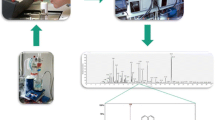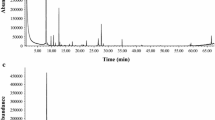Abstract
Based on the observation that the characteristic odour of inflatable aquatic toys for children is predominantly caused by residues of hazardous organic solvents, the concentrations of cyclohexanone, isophorone and phenol were determined in a selection of 20 products obtained from online suppliers located in Germany. Analytes were extracted with dichloromethane after the addition of non-labelled internal standards, and the volatile fraction was isolated using solvent-assisted flavour evaporation (SAFE). Extracts were then concentrated by Vigreux distillation and analysed by means of gas chromatography with mass spectrometric detection (GC-MS). Furthermore, each sample was evaluated regarding its specific olfactory properties by an expert sensory panel. While some samples did not contain significant amounts of solvents, cyclohexanone concentrations above the lower limit of quantification (LLOQ) were determined in nine samples with six samples containing high concentrations ranging from about 1 to 7 g/kg cyclohexanone. Isophorone concentrations above the LLOQ were observed in eight samples. Thereby, six products contained between 0.3 and 1.6 g/kg isophorone and the remaining two samples contained even about 5 g/kg isophorone, each. Likewise, phenol concentrations exceeded the LLOQ in 14 cases, with four samples containing elevated amounts ranging from about 140 to 280 mg/kg phenol.




Similar content being viewed by others
References
Wiedmer C, Velasco-Schön C, Buettner A. Characterization of odorants in inflatable aquatic toys and swimming learning devices—which substances are causative for the characteristic odor and potentially harmful? Anal Bioanal Chem. 2017;409(16):3905–16. https://doi.org/10.1007/s00216-017-0330-x.
European Commission. Regulation (EC) No 1272/2008 of the European Parliament and of the Council of 16 December 2008 on classification, labelling and packaging of substances and mixtures. 2008. http://eur-lex.europa.eu/LexUriServ/LexUriServ.do?uri=OJ:L:2008:353:0001:1355:en:PDF.
Tirendi S, Geiss O, Barrero-Moreno J, Kotzias D. Chemical emissions from toys—the case of stink blasters. Int J Environ Anal Chem. 2009;89(8–12):929–38. https://doi.org/10.1080/03067310802570959.
Nilsson NH, Malmgren-Hansen B, Bernth N, Pedersen E, Pommer K. Survey and health assesment of chemicals substances in sex toys. 2006. http://www2.mst.dk/udgiv/publications/2006/87-7052-227-8/pdf/87-7052-228-6.pdf.
van Den Dool H, Dec. Kratz P. A generalization of the retention index system including linear temperature programmed gas-liquid partition chromatography. J Chrom A. 1963;11(11):463–71. https://doi.org/10.1016/s0021-9673(01)80947-x.
Engel W, Bahr W, Schieberle P. Solvent assisted flavour evaporation—a new and versatile technique for the careful and direct isolation of aroma compounds from complex food matrices. Eur Food Res Technol. 1999;209(3–4):237–41. https://doi.org/10.1007/s002170050486.
U.S. Food and Drug Administration. Guidance for industry—bioanalytical method validation. 2001. https://www.fda.gov/downloads/Drugs/Guidance/ucm070107.pdf.
Friedland K, Harteneck C. Spices and odorants as TRP channel activators—smell, taste, chemesthesis and beyond. In: Büttner A, editor. Springer handbook of odour. Cham: Springer International Publishing; 2016.
Lehmann R, Schöbel N, Hatt H, van Thriel C. The involvement of TRP channels in sensory irritation: a mechanistic approach toward a better understanding of the biological effects of local irritants. Arch Toxicol. 2016;90(6):1399–413. https://doi.org/10.1007/s00204-016-1703-1.
EFSA Panel on food contact materials, enzymes, flavourings processing aids. Scientific opinion on the toxicological evaluation of phenol 2013;11(4):3189. doi:https://doi.org/10.2903/j.efsa.2013.3189.
U.S. Department of Health & Human Services - Centers for Disease Control and Prevention. Occupational safety and health guideline for cyclohexanone. 1988. https://www.cdc.gov/niosh/docs/81-123/pdfs/0166.pdf. Accessed 02 June 2017.
U.S. Department of Health & Human Services - Centers for Disease Control and Prevention. Occupational safety and health guideline for isophorone. 1988. https://www.cdc.gov/niosh/docs/81-123/pdfs/0355.pdf. Accessed 02 June 2017.
Biedermann-Brem S, Biedermann M, Pfenninger S, Bauer M, Altkofer W, Rieger K, et al. Plasticizers in PVC toys and childcare products: what succeeds the phthalates? Market survey 2007. Chromatographia. 2008;68(3):227–34. https://doi.org/10.1365/s10337-008-0672-9.
Stringer R, Labunska I, Santillo D, Johnston P, Siddorn J, Stephenson A. Concentrations of phthalate esters and identification of other additives in PVC children’s toys. Environ Sci Pollut Res. 2000;7(1):27–36. https://doi.org/10.1065/espr199910.007.
Wiedmer C, Velasco-Schön C, Buettner A. Characterization of off-odours and potentially harmful substances in a fancy dress accessory handbag for children. Sci Rep. 2017;7(1):1807. https://doi.org/10.1038/s41598-017-01720-5.
Bundesinstitut für Risikobewertung. Empfehlung XLVII des Bundesinstituts für Risikobewertung zu Spielzeug aus Kunststoffen und anderen Polymeren sowie aus Papier, Karton und Pappe. 2003. https://bfr.ble.de/kse/faces/resources/pdf/470.pdf
Acknowledgements
The authors would like to thank Cristina Velasco-Schön, PhD, and Herbert Wächter, PhD, for their support regarding the evaluation of legal and product safety aspects. We also thank Reinhilde Albrecht and Robin Maier for their skilled help during method development.
Funding sources
This study was funded by the Bavarian State Ministry of Environment and Consumer Safety (StMUV).
Author information
Authors and Affiliations
Corresponding author
Ethics declarations
The study was conducted in agreement with the Declaration of Helsinki. The study (registration number 180_16B) was approved by the Ethical Committee of the Medical Faculty, Friedrich-Alexander Universität Erlangen-Nürnberg. Informed consent was obtained from all subjects participating in the study.
Conflict of interest
The authors declare that they have no competing interests.
Electronic supplementary material
ESM 1
(PDF 142 kb)
Rights and permissions
About this article
Cite this article
Wiedmer, C., Buettner, A. Quantification of organic solvents in aquatic toys and swimming learning devices and evaluation of their influence on the smell properties of the corresponding products. Anal Bioanal Chem 410, 2585–2595 (2018). https://doi.org/10.1007/s00216-018-0929-6
Received:
Revised:
Accepted:
Published:
Issue Date:
DOI: https://doi.org/10.1007/s00216-018-0929-6




